Strategic HRM and Individual Performance Related Pay
VerifiedAdded on 2023/01/16
|8
|2757
|60
AI Summary
This report discusses the role of strategic HRM in implementing individual performance related pay (IPRP) and examines how IPRP can stimulate higher levels of employee performance. It also explores the reasons why IPRP tends to motivate employees in some situations but not in others. The report highlights the importance of job satisfaction, productivity, and motivation in determining the effectiveness of performance-related pay schemes.
Contribute Materials
Your contribution can guide someone’s learning journey. Share your
documents today.
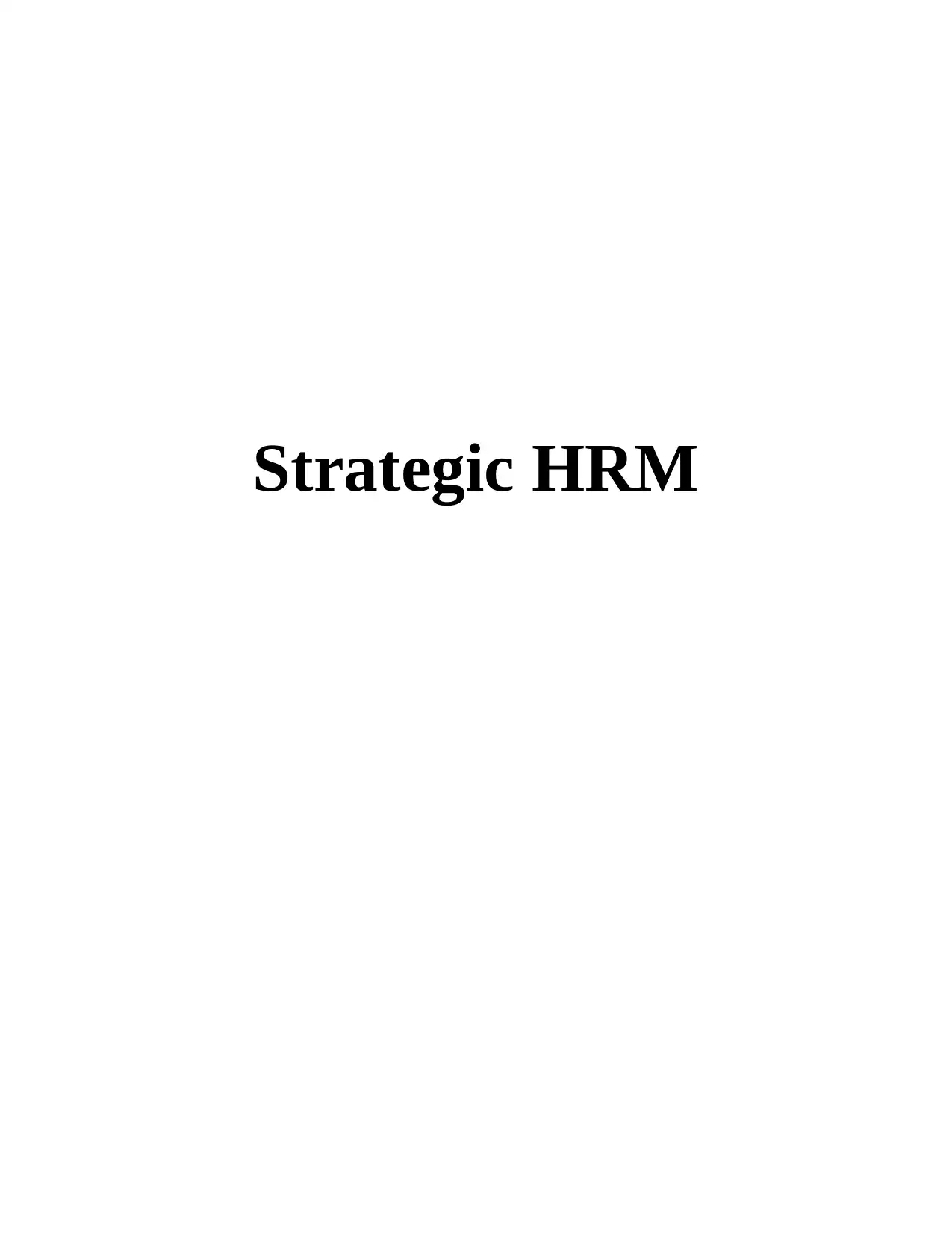
Strategic HRM
Secure Best Marks with AI Grader
Need help grading? Try our AI Grader for instant feedback on your assignments.
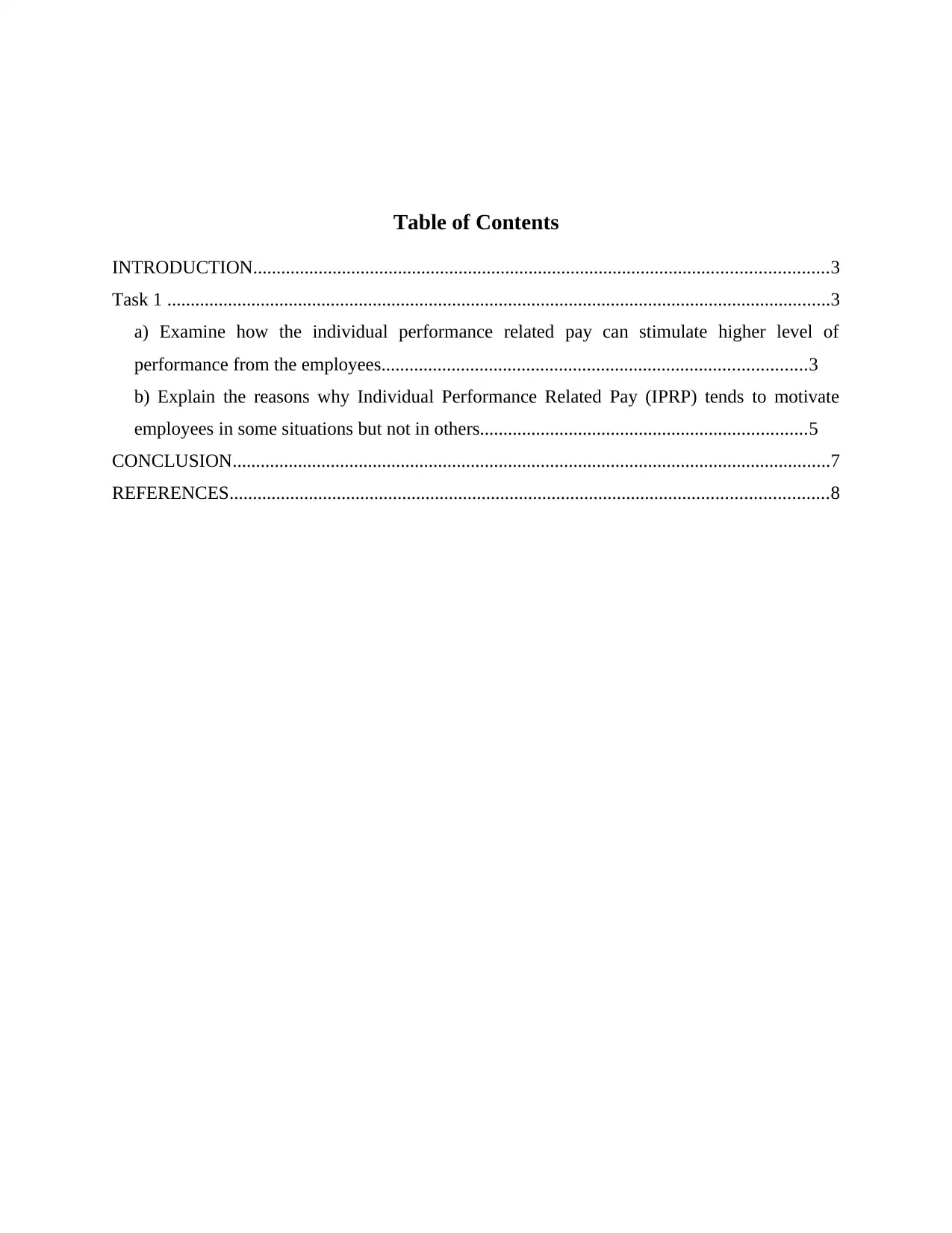
Table of Contents
INTRODUCTION...........................................................................................................................3
Task 1 ..............................................................................................................................................3
a) Examine how the individual performance related pay can stimulate higher level of
performance from the employees...........................................................................................3
b) Explain the reasons why Individual Performance Related Pay (IPRP) tends to motivate
employees in some situations but not in others......................................................................5
CONCLUSION................................................................................................................................7
REFERENCES................................................................................................................................8
INTRODUCTION...........................................................................................................................3
Task 1 ..............................................................................................................................................3
a) Examine how the individual performance related pay can stimulate higher level of
performance from the employees...........................................................................................3
b) Explain the reasons why Individual Performance Related Pay (IPRP) tends to motivate
employees in some situations but not in others......................................................................5
CONCLUSION................................................................................................................................7
REFERENCES................................................................................................................................8
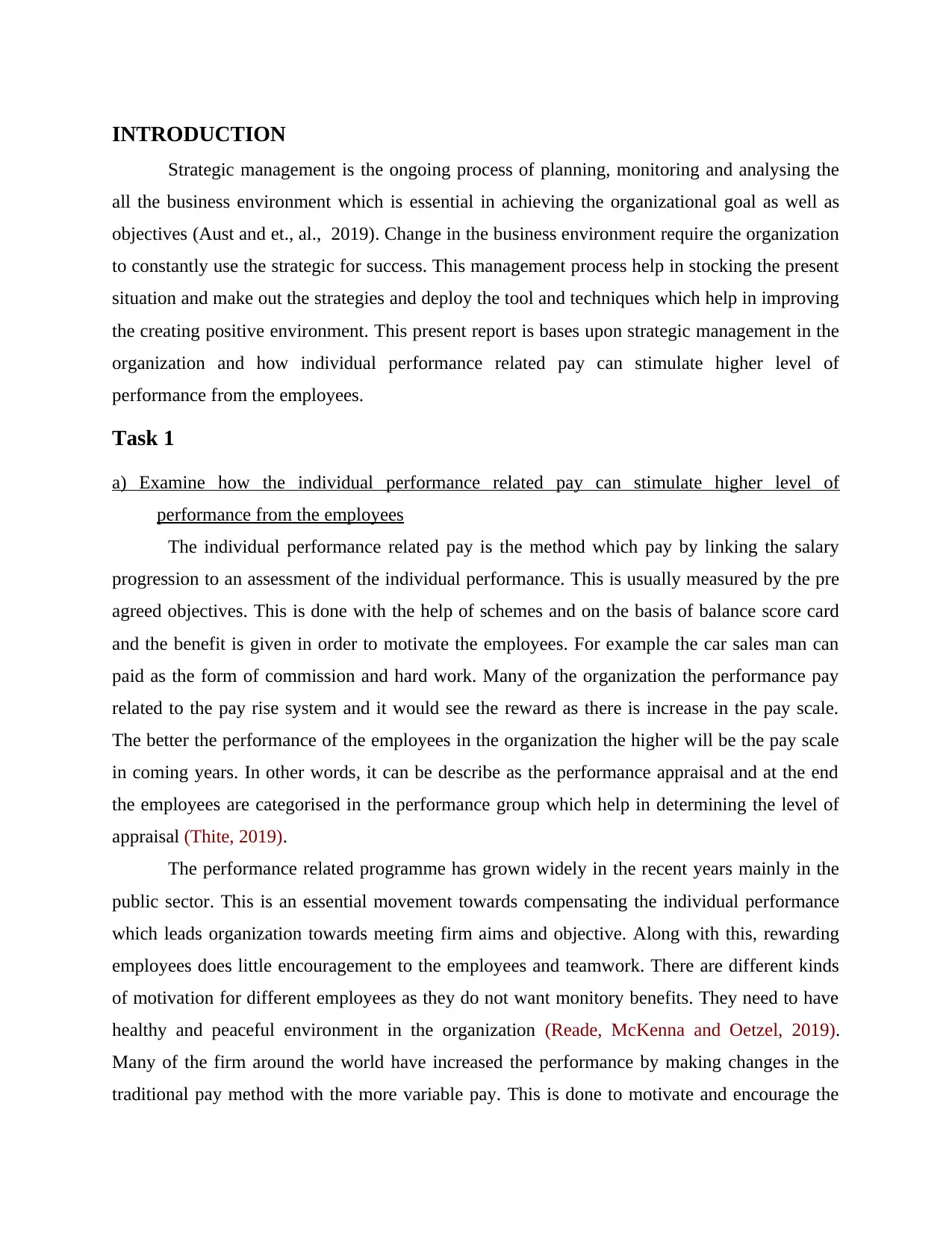
INTRODUCTION
Strategic management is the ongoing process of planning, monitoring and analysing the
all the business environment which is essential in achieving the organizational goal as well as
objectives (Aust and et., al., 2019). Change in the business environment require the organization
to constantly use the strategic for success. This management process help in stocking the present
situation and make out the strategies and deploy the tool and techniques which help in improving
the creating positive environment. This present report is bases upon strategic management in the
organization and how individual performance related pay can stimulate higher level of
performance from the employees.
Task 1
a) Examine how the individual performance related pay can stimulate higher level of
performance from the employees
The individual performance related pay is the method which pay by linking the salary
progression to an assessment of the individual performance. This is usually measured by the pre
agreed objectives. This is done with the help of schemes and on the basis of balance score card
and the benefit is given in order to motivate the employees. For example the car sales man can
paid as the form of commission and hard work. Many of the organization the performance pay
related to the pay rise system and it would see the reward as there is increase in the pay scale.
The better the performance of the employees in the organization the higher will be the pay scale
in coming years. In other words, it can be describe as the performance appraisal and at the end
the employees are categorised in the performance group which help in determining the level of
appraisal (Thite, 2019).
The performance related programme has grown widely in the recent years mainly in the
public sector. This is an essential movement towards compensating the individual performance
which leads organization towards meeting firm aims and objective. Along with this, rewarding
employees does little encouragement to the employees and teamwork. There are different kinds
of motivation for different employees as they do not want monitory benefits. They need to have
healthy and peaceful environment in the organization (Reade, McKenna and Oetzel, 2019).
Many of the firm around the world have increased the performance by making changes in the
traditional pay method with the more variable pay. This is done to motivate and encourage the
Strategic management is the ongoing process of planning, monitoring and analysing the
all the business environment which is essential in achieving the organizational goal as well as
objectives (Aust and et., al., 2019). Change in the business environment require the organization
to constantly use the strategic for success. This management process help in stocking the present
situation and make out the strategies and deploy the tool and techniques which help in improving
the creating positive environment. This present report is bases upon strategic management in the
organization and how individual performance related pay can stimulate higher level of
performance from the employees.
Task 1
a) Examine how the individual performance related pay can stimulate higher level of
performance from the employees
The individual performance related pay is the method which pay by linking the salary
progression to an assessment of the individual performance. This is usually measured by the pre
agreed objectives. This is done with the help of schemes and on the basis of balance score card
and the benefit is given in order to motivate the employees. For example the car sales man can
paid as the form of commission and hard work. Many of the organization the performance pay
related to the pay rise system and it would see the reward as there is increase in the pay scale.
The better the performance of the employees in the organization the higher will be the pay scale
in coming years. In other words, it can be describe as the performance appraisal and at the end
the employees are categorised in the performance group which help in determining the level of
appraisal (Thite, 2019).
The performance related programme has grown widely in the recent years mainly in the
public sector. This is an essential movement towards compensating the individual performance
which leads organization towards meeting firm aims and objective. Along with this, rewarding
employees does little encouragement to the employees and teamwork. There are different kinds
of motivation for different employees as they do not want monitory benefits. They need to have
healthy and peaceful environment in the organization (Reade, McKenna and Oetzel, 2019).
Many of the firm around the world have increased the performance by making changes in the
traditional pay method with the more variable pay. This is done to motivate and encourage the
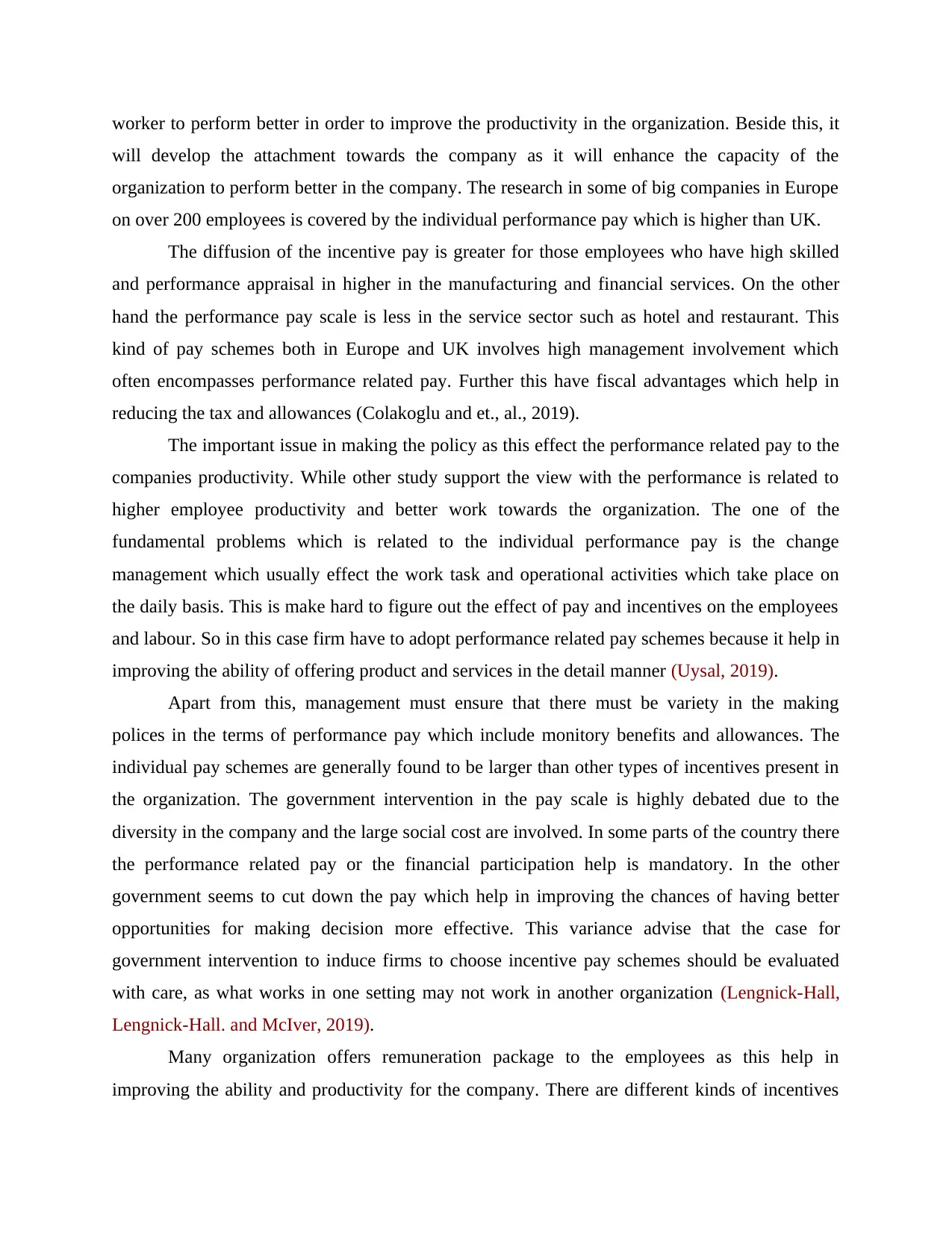
worker to perform better in order to improve the productivity in the organization. Beside this, it
will develop the attachment towards the company as it will enhance the capacity of the
organization to perform better in the company. The research in some of big companies in Europe
on over 200 employees is covered by the individual performance pay which is higher than UK.
The diffusion of the incentive pay is greater for those employees who have high skilled
and performance appraisal in higher in the manufacturing and financial services. On the other
hand the performance pay scale is less in the service sector such as hotel and restaurant. This
kind of pay schemes both in Europe and UK involves high management involvement which
often encompasses performance related pay. Further this have fiscal advantages which help in
reducing the tax and allowances (Colakoglu and et., al., 2019).
The important issue in making the policy as this effect the performance related pay to the
companies productivity. While other study support the view with the performance is related to
higher employee productivity and better work towards the organization. The one of the
fundamental problems which is related to the individual performance pay is the change
management which usually effect the work task and operational activities which take place on
the daily basis. This is make hard to figure out the effect of pay and incentives on the employees
and labour. So in this case firm have to adopt performance related pay schemes because it help in
improving the ability of offering product and services in the detail manner (Uysal, 2019).
Apart from this, management must ensure that there must be variety in the making
polices in the terms of performance pay which include monitory benefits and allowances. The
individual pay schemes are generally found to be larger than other types of incentives present in
the organization. The government intervention in the pay scale is highly debated due to the
diversity in the company and the large social cost are involved. In some parts of the country there
the performance related pay or the financial participation help is mandatory. In the other
government seems to cut down the pay which help in improving the chances of having better
opportunities for making decision more effective. This variance advise that the case for
government intervention to induce firms to choose incentive pay schemes should be evaluated
with care, as what works in one setting may not work in another organization (Lengnick-Hall,
Lengnick-Hall. and McIver, 2019).
Many organization offers remuneration package to the employees as this help in
improving the ability and productivity for the company. There are different kinds of incentives
will develop the attachment towards the company as it will enhance the capacity of the
organization to perform better in the company. The research in some of big companies in Europe
on over 200 employees is covered by the individual performance pay which is higher than UK.
The diffusion of the incentive pay is greater for those employees who have high skilled
and performance appraisal in higher in the manufacturing and financial services. On the other
hand the performance pay scale is less in the service sector such as hotel and restaurant. This
kind of pay schemes both in Europe and UK involves high management involvement which
often encompasses performance related pay. Further this have fiscal advantages which help in
reducing the tax and allowances (Colakoglu and et., al., 2019).
The important issue in making the policy as this effect the performance related pay to the
companies productivity. While other study support the view with the performance is related to
higher employee productivity and better work towards the organization. The one of the
fundamental problems which is related to the individual performance pay is the change
management which usually effect the work task and operational activities which take place on
the daily basis. This is make hard to figure out the effect of pay and incentives on the employees
and labour. So in this case firm have to adopt performance related pay schemes because it help in
improving the ability of offering product and services in the detail manner (Uysal, 2019).
Apart from this, management must ensure that there must be variety in the making
polices in the terms of performance pay which include monitory benefits and allowances. The
individual pay schemes are generally found to be larger than other types of incentives present in
the organization. The government intervention in the pay scale is highly debated due to the
diversity in the company and the large social cost are involved. In some parts of the country there
the performance related pay or the financial participation help is mandatory. In the other
government seems to cut down the pay which help in improving the chances of having better
opportunities for making decision more effective. This variance advise that the case for
government intervention to induce firms to choose incentive pay schemes should be evaluated
with care, as what works in one setting may not work in another organization (Lengnick-Hall,
Lengnick-Hall. and McIver, 2019).
Many organization offers remuneration package to the employees as this help in
improving the ability and productivity for the company. There are different kinds of incentives
Secure Best Marks with AI Grader
Need help grading? Try our AI Grader for instant feedback on your assignments.
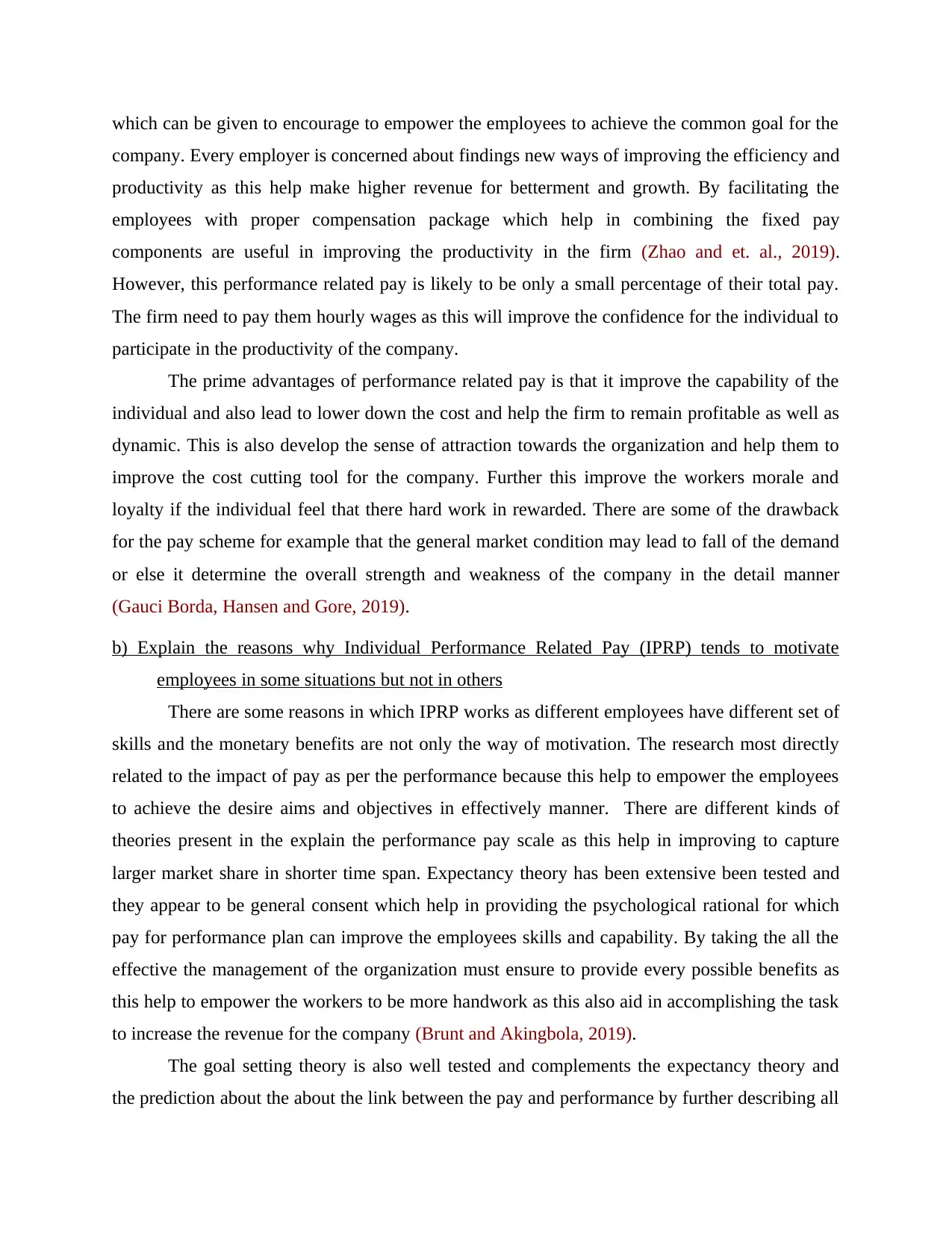
which can be given to encourage to empower the employees to achieve the common goal for the
company. Every employer is concerned about findings new ways of improving the efficiency and
productivity as this help make higher revenue for betterment and growth. By facilitating the
employees with proper compensation package which help in combining the fixed pay
components are useful in improving the productivity in the firm (Zhao and et. al., 2019).
However, this performance related pay is likely to be only a small percentage of their total pay.
The firm need to pay them hourly wages as this will improve the confidence for the individual to
participate in the productivity of the company.
The prime advantages of performance related pay is that it improve the capability of the
individual and also lead to lower down the cost and help the firm to remain profitable as well as
dynamic. This is also develop the sense of attraction towards the organization and help them to
improve the cost cutting tool for the company. Further this improve the workers morale and
loyalty if the individual feel that there hard work in rewarded. There are some of the drawback
for the pay scheme for example that the general market condition may lead to fall of the demand
or else it determine the overall strength and weakness of the company in the detail manner
(Gauci Borda, Hansen and Gore, 2019).
b) Explain the reasons why Individual Performance Related Pay (IPRP) tends to motivate
employees in some situations but not in others
There are some reasons in which IPRP works as different employees have different set of
skills and the monetary benefits are not only the way of motivation. The research most directly
related to the impact of pay as per the performance because this help to empower the employees
to achieve the desire aims and objectives in effectively manner. There are different kinds of
theories present in the explain the performance pay scale as this help in improving to capture
larger market share in shorter time span. Expectancy theory has been extensive been tested and
they appear to be general consent which help in providing the psychological rational for which
pay for performance plan can improve the employees skills and capability. By taking the all the
effective the management of the organization must ensure to provide every possible benefits as
this help to empower the workers to be more handwork as this also aid in accomplishing the task
to increase the revenue for the company (Brunt and Akingbola, 2019).
The goal setting theory is also well tested and complements the expectancy theory and
the prediction about the about the link between the pay and performance by further describing all
company. Every employer is concerned about findings new ways of improving the efficiency and
productivity as this help make higher revenue for betterment and growth. By facilitating the
employees with proper compensation package which help in combining the fixed pay
components are useful in improving the productivity in the firm (Zhao and et. al., 2019).
However, this performance related pay is likely to be only a small percentage of their total pay.
The firm need to pay them hourly wages as this will improve the confidence for the individual to
participate in the productivity of the company.
The prime advantages of performance related pay is that it improve the capability of the
individual and also lead to lower down the cost and help the firm to remain profitable as well as
dynamic. This is also develop the sense of attraction towards the organization and help them to
improve the cost cutting tool for the company. Further this improve the workers morale and
loyalty if the individual feel that there hard work in rewarded. There are some of the drawback
for the pay scheme for example that the general market condition may lead to fall of the demand
or else it determine the overall strength and weakness of the company in the detail manner
(Gauci Borda, Hansen and Gore, 2019).
b) Explain the reasons why Individual Performance Related Pay (IPRP) tends to motivate
employees in some situations but not in others
There are some reasons in which IPRP works as different employees have different set of
skills and the monetary benefits are not only the way of motivation. The research most directly
related to the impact of pay as per the performance because this help to empower the employees
to achieve the desire aims and objectives in effectively manner. There are different kinds of
theories present in the explain the performance pay scale as this help in improving to capture
larger market share in shorter time span. Expectancy theory has been extensive been tested and
they appear to be general consent which help in providing the psychological rational for which
pay for performance plan can improve the employees skills and capability. By taking the all the
effective the management of the organization must ensure to provide every possible benefits as
this help to empower the workers to be more handwork as this also aid in accomplishing the task
to increase the revenue for the company (Brunt and Akingbola, 2019).
The goal setting theory is also well tested and complements the expectancy theory and
the prediction about the about the link between the pay and performance by further describing all
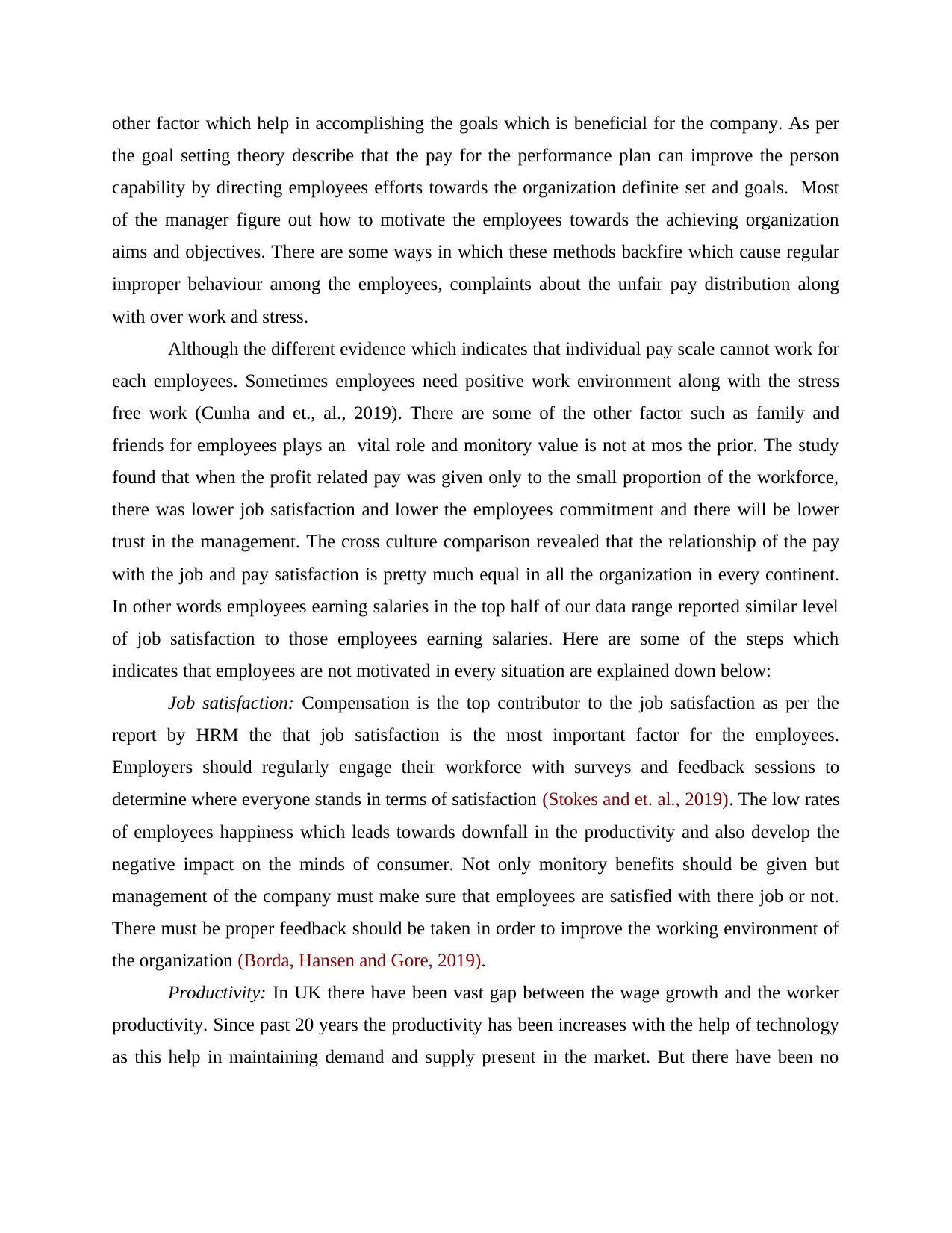
other factor which help in accomplishing the goals which is beneficial for the company. As per
the goal setting theory describe that the pay for the performance plan can improve the person
capability by directing employees efforts towards the organization definite set and goals. Most
of the manager figure out how to motivate the employees towards the achieving organization
aims and objectives. There are some ways in which these methods backfire which cause regular
improper behaviour among the employees, complaints about the unfair pay distribution along
with over work and stress.
Although the different evidence which indicates that individual pay scale cannot work for
each employees. Sometimes employees need positive work environment along with the stress
free work (Cunha and et., al., 2019). There are some of the other factor such as family and
friends for employees plays an vital role and monitory value is not at mos the prior. The study
found that when the profit related pay was given only to the small proportion of the workforce,
there was lower job satisfaction and lower the employees commitment and there will be lower
trust in the management. The cross culture comparison revealed that the relationship of the pay
with the job and pay satisfaction is pretty much equal in all the organization in every continent.
In other words employees earning salaries in the top half of our data range reported similar level
of job satisfaction to those employees earning salaries. Here are some of the steps which
indicates that employees are not motivated in every situation are explained down below:
Job satisfaction: Compensation is the top contributor to the job satisfaction as per the
report by HRM the that job satisfaction is the most important factor for the employees.
Employers should regularly engage their workforce with surveys and feedback sessions to
determine where everyone stands in terms of satisfaction (Stokes and et. al., 2019). The low rates
of employees happiness which leads towards downfall in the productivity and also develop the
negative impact on the minds of consumer. Not only monitory benefits should be given but
management of the company must make sure that employees are satisfied with there job or not.
There must be proper feedback should be taken in order to improve the working environment of
the organization (Borda, Hansen and Gore, 2019).
Productivity: In UK there have been vast gap between the wage growth and the worker
productivity. Since past 20 years the productivity has been increases with the help of technology
as this help in maintaining demand and supply present in the market. But there have been no
the goal setting theory describe that the pay for the performance plan can improve the person
capability by directing employees efforts towards the organization definite set and goals. Most
of the manager figure out how to motivate the employees towards the achieving organization
aims and objectives. There are some ways in which these methods backfire which cause regular
improper behaviour among the employees, complaints about the unfair pay distribution along
with over work and stress.
Although the different evidence which indicates that individual pay scale cannot work for
each employees. Sometimes employees need positive work environment along with the stress
free work (Cunha and et., al., 2019). There are some of the other factor such as family and
friends for employees plays an vital role and monitory value is not at mos the prior. The study
found that when the profit related pay was given only to the small proportion of the workforce,
there was lower job satisfaction and lower the employees commitment and there will be lower
trust in the management. The cross culture comparison revealed that the relationship of the pay
with the job and pay satisfaction is pretty much equal in all the organization in every continent.
In other words employees earning salaries in the top half of our data range reported similar level
of job satisfaction to those employees earning salaries. Here are some of the steps which
indicates that employees are not motivated in every situation are explained down below:
Job satisfaction: Compensation is the top contributor to the job satisfaction as per the
report by HRM the that job satisfaction is the most important factor for the employees.
Employers should regularly engage their workforce with surveys and feedback sessions to
determine where everyone stands in terms of satisfaction (Stokes and et. al., 2019). The low rates
of employees happiness which leads towards downfall in the productivity and also develop the
negative impact on the minds of consumer. Not only monitory benefits should be given but
management of the company must make sure that employees are satisfied with there job or not.
There must be proper feedback should be taken in order to improve the working environment of
the organization (Borda, Hansen and Gore, 2019).
Productivity: In UK there have been vast gap between the wage growth and the worker
productivity. Since past 20 years the productivity has been increases with the help of technology
as this help in maintaining demand and supply present in the market. But there have been no
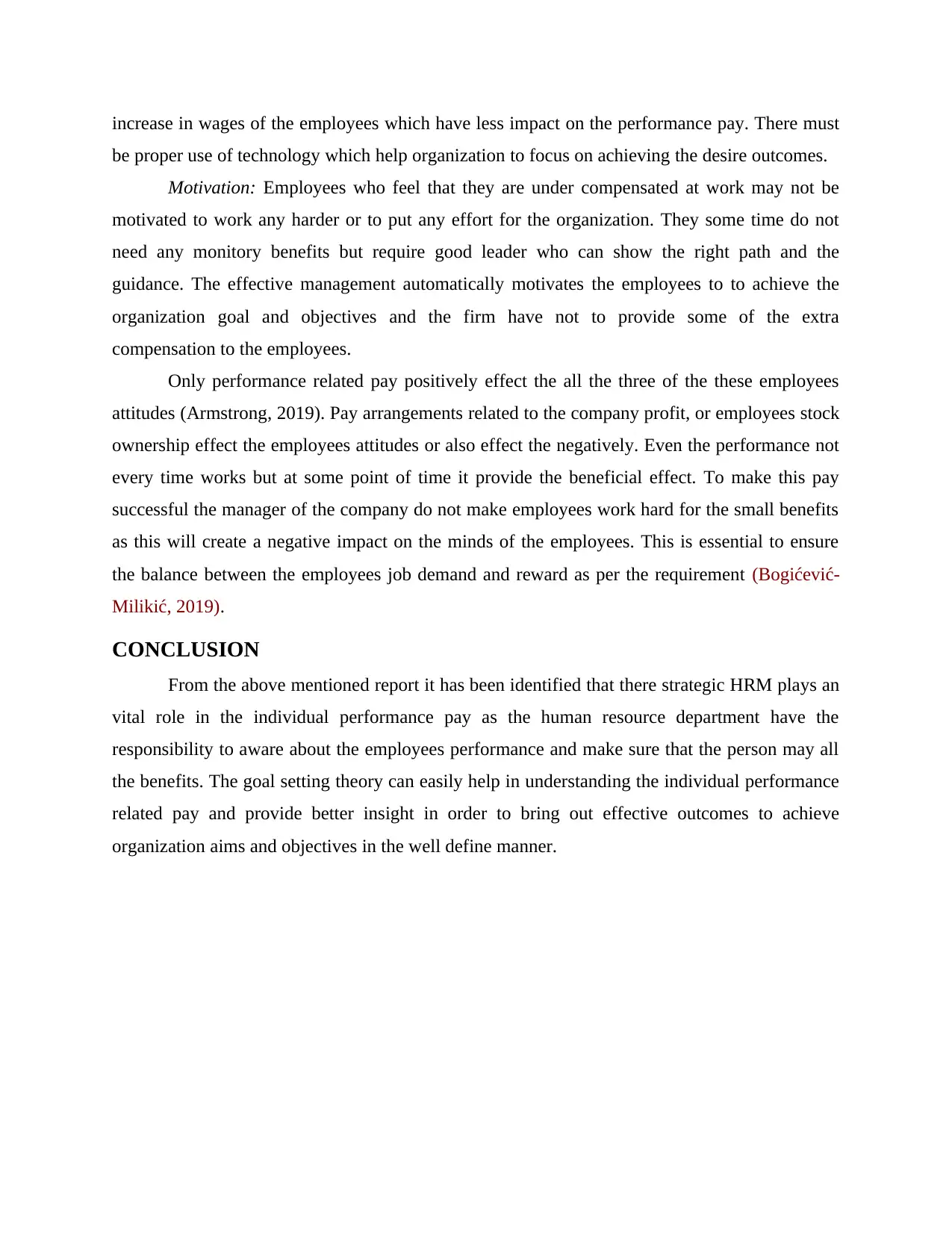
increase in wages of the employees which have less impact on the performance pay. There must
be proper use of technology which help organization to focus on achieving the desire outcomes.
Motivation: Employees who feel that they are under compensated at work may not be
motivated to work any harder or to put any effort for the organization. They some time do not
need any monitory benefits but require good leader who can show the right path and the
guidance. The effective management automatically motivates the employees to to achieve the
organization goal and objectives and the firm have not to provide some of the extra
compensation to the employees.
Only performance related pay positively effect the all the three of the these employees
attitudes (Armstrong, 2019). Pay arrangements related to the company profit, or employees stock
ownership effect the employees attitudes or also effect the negatively. Even the performance not
every time works but at some point of time it provide the beneficial effect. To make this pay
successful the manager of the company do not make employees work hard for the small benefits
as this will create a negative impact on the minds of the employees. This is essential to ensure
the balance between the employees job demand and reward as per the requirement (Bogićević-
Milikić, 2019).
CONCLUSION
From the above mentioned report it has been identified that there strategic HRM plays an
vital role in the individual performance pay as the human resource department have the
responsibility to aware about the employees performance and make sure that the person may all
the benefits. The goal setting theory can easily help in understanding the individual performance
related pay and provide better insight in order to bring out effective outcomes to achieve
organization aims and objectives in the well define manner.
be proper use of technology which help organization to focus on achieving the desire outcomes.
Motivation: Employees who feel that they are under compensated at work may not be
motivated to work any harder or to put any effort for the organization. They some time do not
need any monitory benefits but require good leader who can show the right path and the
guidance. The effective management automatically motivates the employees to to achieve the
organization goal and objectives and the firm have not to provide some of the extra
compensation to the employees.
Only performance related pay positively effect the all the three of the these employees
attitudes (Armstrong, 2019). Pay arrangements related to the company profit, or employees stock
ownership effect the employees attitudes or also effect the negatively. Even the performance not
every time works but at some point of time it provide the beneficial effect. To make this pay
successful the manager of the company do not make employees work hard for the small benefits
as this will create a negative impact on the minds of the employees. This is essential to ensure
the balance between the employees job demand and reward as per the requirement (Bogićević-
Milikić, 2019).
CONCLUSION
From the above mentioned report it has been identified that there strategic HRM plays an
vital role in the individual performance pay as the human resource department have the
responsibility to aware about the employees performance and make sure that the person may all
the benefits. The goal setting theory can easily help in understanding the individual performance
related pay and provide better insight in order to bring out effective outcomes to achieve
organization aims and objectives in the well define manner.
Paraphrase This Document
Need a fresh take? Get an instant paraphrase of this document with our AI Paraphraser
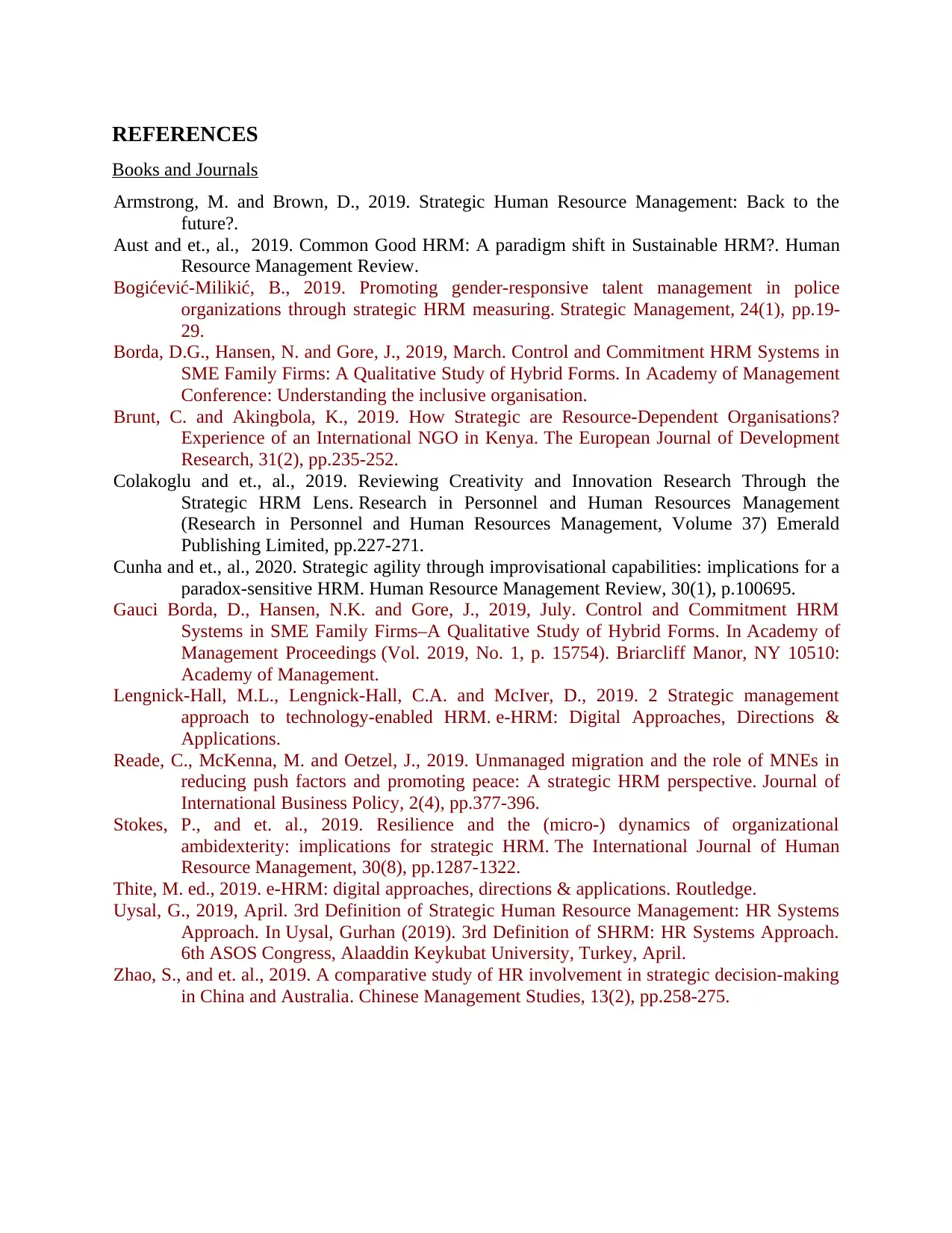
REFERENCES
Books and Journals
Armstrong, M. and Brown, D., 2019. Strategic Human Resource Management: Back to the
future?.
Aust and et., al., 2019. Common Good HRM: A paradigm shift in Sustainable HRM?. Human
Resource Management Review.
Bogićević-Milikić, B., 2019. Promoting gender-responsive talent management in police
organizations through strategic HRM measuring. Strategic Management, 24(1), pp.19-
29.
Borda, D.G., Hansen, N. and Gore, J., 2019, March. Control and Commitment HRM Systems in
SME Family Firms: A Qualitative Study of Hybrid Forms. In Academy of Management
Conference: Understanding the inclusive organisation.
Brunt, C. and Akingbola, K., 2019. How Strategic are Resource-Dependent Organisations?
Experience of an International NGO in Kenya. The European Journal of Development
Research, 31(2), pp.235-252.
Colakoglu and et., al., 2019. Reviewing Creativity and Innovation Research Through the
Strategic HRM Lens. Research in Personnel and Human Resources Management
(Research in Personnel and Human Resources Management, Volume 37) Emerald
Publishing Limited, pp.227-271.
Cunha and et., al., 2020. Strategic agility through improvisational capabilities: implications for a
paradox-sensitive HRM. Human Resource Management Review, 30(1), p.100695.
Gauci Borda, D., Hansen, N.K. and Gore, J., 2019, July. Control and Commitment HRM
Systems in SME Family Firms–A Qualitative Study of Hybrid Forms. In Academy of
Management Proceedings (Vol. 2019, No. 1, p. 15754). Briarcliff Manor, NY 10510:
Academy of Management.
Lengnick-Hall, M.L., Lengnick-Hall, C.A. and McIver, D., 2019. 2 Strategic management
approach to technology-enabled HRM. e-HRM: Digital Approaches, Directions &
Applications.
Reade, C., McKenna, M. and Oetzel, J., 2019. Unmanaged migration and the role of MNEs in
reducing push factors and promoting peace: A strategic HRM perspective. Journal of
International Business Policy, 2(4), pp.377-396.
Stokes, P., and et. al., 2019. Resilience and the (micro-) dynamics of organizational
ambidexterity: implications for strategic HRM. The International Journal of Human
Resource Management, 30(8), pp.1287-1322.
Thite, M. ed., 2019. e-HRM: digital approaches, directions & applications. Routledge.
Uysal, G., 2019, April. 3rd Definition of Strategic Human Resource Management: HR Systems
Approach. In Uysal, Gurhan (2019). 3rd Definition of SHRM: HR Systems Approach.
6th ASOS Congress, Alaaddin Keykubat University, Turkey, April.
Zhao, S., and et. al., 2019. A comparative study of HR involvement in strategic decision-making
in China and Australia. Chinese Management Studies, 13(2), pp.258-275.
Books and Journals
Armstrong, M. and Brown, D., 2019. Strategic Human Resource Management: Back to the
future?.
Aust and et., al., 2019. Common Good HRM: A paradigm shift in Sustainable HRM?. Human
Resource Management Review.
Bogićević-Milikić, B., 2019. Promoting gender-responsive talent management in police
organizations through strategic HRM measuring. Strategic Management, 24(1), pp.19-
29.
Borda, D.G., Hansen, N. and Gore, J., 2019, March. Control and Commitment HRM Systems in
SME Family Firms: A Qualitative Study of Hybrid Forms. In Academy of Management
Conference: Understanding the inclusive organisation.
Brunt, C. and Akingbola, K., 2019. How Strategic are Resource-Dependent Organisations?
Experience of an International NGO in Kenya. The European Journal of Development
Research, 31(2), pp.235-252.
Colakoglu and et., al., 2019. Reviewing Creativity and Innovation Research Through the
Strategic HRM Lens. Research in Personnel and Human Resources Management
(Research in Personnel and Human Resources Management, Volume 37) Emerald
Publishing Limited, pp.227-271.
Cunha and et., al., 2020. Strategic agility through improvisational capabilities: implications for a
paradox-sensitive HRM. Human Resource Management Review, 30(1), p.100695.
Gauci Borda, D., Hansen, N.K. and Gore, J., 2019, July. Control and Commitment HRM
Systems in SME Family Firms–A Qualitative Study of Hybrid Forms. In Academy of
Management Proceedings (Vol. 2019, No. 1, p. 15754). Briarcliff Manor, NY 10510:
Academy of Management.
Lengnick-Hall, M.L., Lengnick-Hall, C.A. and McIver, D., 2019. 2 Strategic management
approach to technology-enabled HRM. e-HRM: Digital Approaches, Directions &
Applications.
Reade, C., McKenna, M. and Oetzel, J., 2019. Unmanaged migration and the role of MNEs in
reducing push factors and promoting peace: A strategic HRM perspective. Journal of
International Business Policy, 2(4), pp.377-396.
Stokes, P., and et. al., 2019. Resilience and the (micro-) dynamics of organizational
ambidexterity: implications for strategic HRM. The International Journal of Human
Resource Management, 30(8), pp.1287-1322.
Thite, M. ed., 2019. e-HRM: digital approaches, directions & applications. Routledge.
Uysal, G., 2019, April. 3rd Definition of Strategic Human Resource Management: HR Systems
Approach. In Uysal, Gurhan (2019). 3rd Definition of SHRM: HR Systems Approach.
6th ASOS Congress, Alaaddin Keykubat University, Turkey, April.
Zhao, S., and et. al., 2019. A comparative study of HR involvement in strategic decision-making
in China and Australia. Chinese Management Studies, 13(2), pp.258-275.
1 out of 8
Related Documents
Your All-in-One AI-Powered Toolkit for Academic Success.
+13062052269
info@desklib.com
Available 24*7 on WhatsApp / Email
![[object Object]](/_next/static/media/star-bottom.7253800d.svg)
Unlock your academic potential
© 2024 | Zucol Services PVT LTD | All rights reserved.





